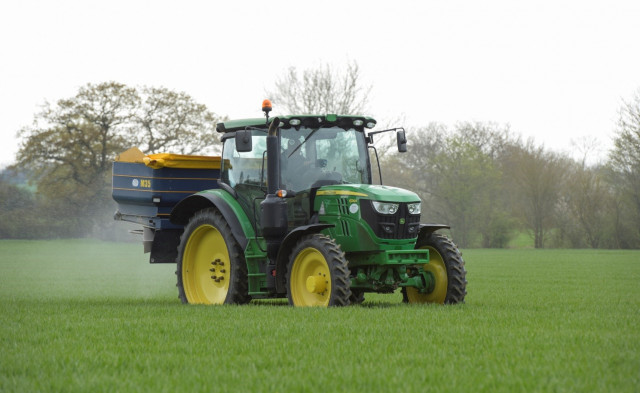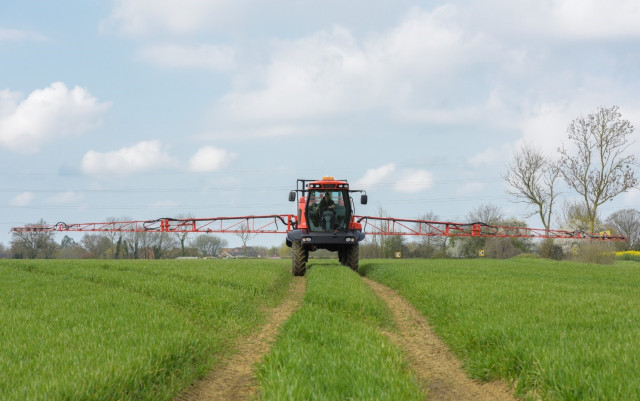Nitrogen guidance for milling wheat
At this time of year, I'm often asked: "How much nitrogen should I apply to my milling wheat crops?" My tongue-in-cheek response to that question is often: "Tell me exactly how much your crop is going to yield and then I'll be able to give you a guide on nitrogen rates. "Now, clearly it is impossible to know the exact yield you are going to achieve at this stage so a definitive answer will always be hard but even so, I believe all milling wheat growers should fully understand the impact yield has on the nitrogen requirement for their crops.
Nitrogen uptake calculation
The total nitrogen uptake for a 13% protein milling wheat crop can be worked out using the calculation below. For contracts with a 12.5% target – such as that for Warburtons – the levels will be lower.
1. Yield x grain protein = grain nitrogen offtake (kg/ha)
2. Grain nitrogen offtake ÷ 68% = total nitrogen uptake (kg/ha)
Example - 8t/ha at 13% protein = 155kg/ha offtake = 228kg/ha uptake
6800kg dry matter yield/ha x 2.28%N (13% ÷ 5.7) = 155 ÷ 0.68 = 228kg/ha
A total nitrogen uptake of 228kg/ha may not seem excessive but this soon increases as yield improves. You can see this highlighted in the table below – for this reason I often say the easiest way to achieve the grain protein required for milling is to grow a modest yield.
| Yield (t/ha) |
Grain nitrogen offtake (kg/ha) |
Total nitrogen uptake (kg/ha) |
| 8 | 155 | 228 |
| 9 | 174 | 257 |
| 10 | 194 | 285 |
| 11 | 213 | 314 |
| 12 | 233 | 342 |
It's not quite as bad as these figures suggest, as big crops are often more efficient at taking up nitrogen. However, you can't get away from the challenge to supply enough to those high yielding crops.
What impact do current high fertiliser prices have?
Unfortunately, you can't use the breakeven ratio (BER) calculation that looks at the cost of nitrogen in relation to the value of grain because that only applies to feed crops; it only takes account of the economic impact on yield and not on grain protein, which would be impacted first by any reduction in N rate.
If you are growing feed crops…
It is worth noting that you should reassess your BER calculation now given the significant increase in grain price because it will have reduced, therefore justifying the use of higher rates of nitrogen this year. You can learn more about understanding your BER in my previous blog about the value of nitrogen. Also, this is an opportune moment to challenge anyone considering significant cuts to nitrogen rates this year with the aim of saving fertiliser for next year to reduce costs. While this can seem logical, with the value of grain for this harvest as even a small impact to this year's crop yield could very quickly erase any potential saving.
I would suggest the only thing you can do as a milling wheat grower is understand the cost of the extra nitrogen on a per tonne basis, versus the known or potential premium. To do this, multiply your average nitrogen cost per kilo by the extra N you would normally apply over a feed wheat programme (likely to be anywhere between 40-70kg/ha), and then divide this by your normal yield. This doesn't really influence the nitrogen rate as you must hit the required protein level but, by knowing the result, you can then make a balanced assessment of the risk/reward for growing milling wheat.
Grain analysis results
Historic grain analysis results can be very useful alongside any previous yields and nitrogen rates, as they can help assess how successful you've been in previous seasons when you're considering what you do this year. However, it's worth saying that these historic grain results will likely be from a store and so can't be linked directly to individual fields. Going forward, I would strongly encourage you to start sampling grain from individual fields, or at least some barometer fields to better understand the range in performance across your farm. To support growers with this, my colleagues from Frontier and SOYL have developed a broad-spectrum grain analysis service that is designed to give you those important levels and interpretation. More information about how to access the service will be made available soon, as well as covered in a future blog.
Assessing this year's crop potential
Now you have some idea of previous performance, you can compare it to any assessments of this year's crop potential – for example through biomass imagery from SOYL or leaf tissue measurements etc. Any findings will help you decide how much more nitrogen needs to be applied to meet the total nitrogen requirement.
At this point in the season, the final main yield dose of nitrogen will have been applied, so that leaves the protein doses still to come. These can be applied to the soil as solid or liquid around flag leaf emergence and/or foliar nitrogen sprayed at the milky ripe stage. Both generally add about 0.5-1%+ protein depending on conditions and final yield.
As this final application is all about managing potential, I would strongly encourage all outstanding solid or liquid products to be applied variably, enabling the high potential areas in the field to receive more nitrogen. In trials on farm, this process improved protein levels over all the years tested - even with no more nitrogen applied - but particularly in the high yielding years. In addition, for those using liquid fertiliser it would be very sensible to include a urease inhibitor like Limus® Clear to limit any nitrogen (ammonia) losses, which can impact protein and yield performance. If your contract allows, applications of foliar nitrogen such as Multi N at the milky ripe stage can help to increase protein, as crop uptake is less influenced by soil and weather conditions. This later timing also allows for a greater period for assessment and accuracy of crop potential and nitrogen demand.
It's not always easy to achieve the required protein for milling wheat but I hope you can now see the impact yield has when it comes to hitting spec. Using the information from previous seasons alongside current observations can really help to make informed decisions on nitrogen rates and timings. Of course, there's then the small matter of doing everything possible to make the most of every kilo of applied nitrogen – whether from fertiliser and/or manure.
As mentioned, more information on the management of nitrogen and other nutritional products can be found in my previous blog. Equally, fertiliser business development manager, Finley Hawkins has some useful tips for making the most of applications in our latest issue of AGRONOMY.
If you'd like more advice on anything mentioned in this blog, please speak to your local Frontier contact. Alternatively, to get in touch directly with our team you can reach us here.
As a subscriber, you’ll receive email alerts each time a new blog is published so you can always stay updated with the latest advice and insights from our experts






Comments